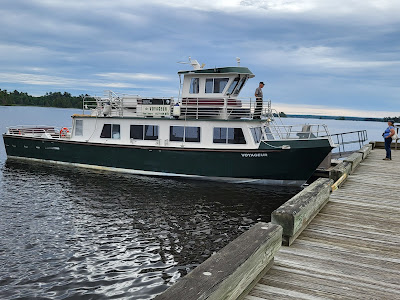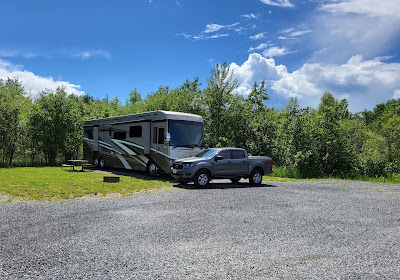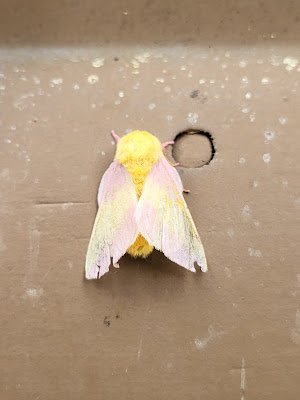We arrived in the Duluth area on June 6. We booked early and were able to reserve a lovely inland lakefront campsite at Red Pine Campground in Saginaw, Minnesota, just 17 miles from downtown Duluth.
This private campground is well maintained and has large sites.
Red Pine Campground Site #55
CANAL PARK AND THE AERIAL LIFT BRIDGE
The Lake Superior Maritime Museum and Visitor Center was our first stop. It is located at the foot of the Aerial Lift Bridge and run by the US Army Corp. of Engineers.
The retired tugboat Bayfield is a permanent resident in front of the Maritime Museum.
This is a restored wheelhouse inside the free museum.
The lift bridge opened on the hour and half hour to a height that would accommodate the waiting ships.
Duluth North Pier Lighthouse
Duluth has a population of about 86,000.
The bridge lift span weighs about 1,000 tons and each of two concrete counterweights are about 500 tons, so the span is almost neutral in weight, requiring very little electrical power to raise and lower.
ENGER PARK AND TOWER
We drove a section of the Skyline Parkway which winds along a ridge that overlooks Duluth and the Twin Harbors.
The Enger Tower and property, located along the Skyline Parkway, were donated to the city of Duluth by the Crown Prince of Norway.
We climbed the five-story tower.
View of Duluth Harbor Entry
Enger Park also has a Japanese Peace Garden complete with a loud Peace Bell.
SUPERIOR ENTRY
Duluth, Minnesota, and Superior, Wisconsin, form the Twin Harbors. The Superior Entry is the only natural opening as it passes through the longest freshwater sandbar in the world. We drove across the St. Louis River on the US 2 bridge to the Wisconsin port.
We walked to the end of the Superior Entry Channel Pier.
Two lighthouses mark the entry through the breakwater.
Superior Ore Docks
SS METEOR AND MARITIME MUSEUM ON BARKERS ISLAND, WISCONSIN
The SS Meteor, built in 1896, is the last remaining above-water whaleback ship in the world.
A whaleback was a type of cargo steamship of unusual design, with a hull that continuously curved above the waterline from vertical to horizontal. When fully loaded, only the rounded portion of the hull (the "whaleback") could be seen above the waterline.
The SS Meteor is 380 feet in length.
The horn is still operable but with reduced volume.
Crew Quarters
Mess Hall
Engine Room with a Chadburn to receive orders from the Bridge.
This Mariner Monument, with his very large boots and small head, creates an optical allusion. Standing under him, looking up he appears much taller than actual size.
Fairlawn Mansion Museum
We drove across the Aerial Lift Bridge and viewed the Viking Expedition Ship, Polaris, in port at Duluth.
WILLIAM A. IRVIN MUSEUM
This retired restored freighter in Duluth Harbor is open for self-guided tours.
The US Steel Corporation Flagship, William A. Irvin, named after the company's president, was built in 1937.
Engine Room
The Galley
The Great Lakes freighter, Irvin, carried cargos of coal, iron ore, and lime.
The 610-foot ship was retired at the end of the 1978 season. She could not compete with the newer, larger, ships that could carry up to five times the cargo and were much faster.
The Irvin has a superstructure at both the bow and the stern. In addition to the wheelhouse and captain's quarters, the bow structure contains four luxury cabins for invited quests.
View of deck and bulk cargo holds from a forward cabin.
"OK my turn to drive."
Stairway into the cargo holds.
LAKE WALK ALONG LAKE SUPERIOR
We walked a very nice two-mile section of the boardwalk and bike path that follows the Superior shore from the Aerial Lift Bridge to the Duluth Rose Garden.
Northland Vietnam Veterans Memorial
Fitgers Historic Brewery
Lief Erickson Park
The Duluth Rose Garden was built above Interstate 35 which tunnels under a portion of the city of Duluth.
LAKE SUPERIOR RAILROAD MUSEUM
The Duluth train depot was built in 1892. It houses a huge selection of full-size railroad engines, cars and equipment trackside under the Depot's Train Shed.
This St. Paul & Pacific engine, built in 1861, is a wood burner.
This dashboard is more complicated than the motorhome.
This mobile post office train serviced remote towns along the line.
The woodburning Number 1 Minnetonka (1870) was the first engine in service on James J. Hill's Northern Pacific Railroad.


























































































